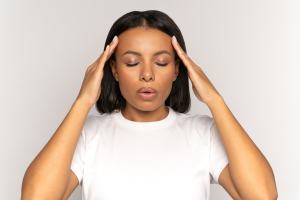Though anxiety affects many individuals, there is no one way to manage it that works for everyone. There are many strategies you can use to neutralize or decrease anxiety symptoms, but some will be more effective for individuals than they are for others.
If you are still finding out what works for you, here are some commonly used techniques for quickly bringing down one’s anxiety levels.

What Neutralizes Anxiety?
The fastest way to neutralize anxiety is to remove or disarm the perceived threat—the cause of your anxiety. For example, a person may feel anxious prior to taking an important exam. Once they take it and receive their grade, though, any anxious thoughts related to the test itself will likely stop, though others might take its place.
However, the cause of one’s anxiety can’t always be removed. There may be cases where things that feel dangerous and are causing anxiety aren’t actual threats. Maybe you have social anxiety and feel anxious in big groups, or maybe you feel anxious in the car be you were in a car crash once. The situations themselves aren’t life-threatening or dangerous in the moment, but you still have an anxious reaction.
This is where learning about and assessing your anxiety becomes important. By clarifying your perspective on what your mind or body identifies as a threat and challenging it, you can change your interpretation of that “threat” and mitigate its impact, allowing you to better counter the effects of anxiety.
How Do I Get Out of an Anxiety Loop?
Getting out of the anxiety loop first starts with recognizing that you are in an anxiety loop, then figuring out where you are in that loop.
An anxiety loop is a broad term that refers to a cyclical pattern of anxious responses that builds anxiety, despite being an attempt to lessen it. This can look different for each person; however, anxiety patterns generally start with:
- Anxious feelings
- Attempts at avoidance
- Temporarily alleviating anxious feelings
- The return of the intense anxious feelings
To help with the intensity of anxious feelings, relaxation techniques can greatly reduce the uncomfortable physical sensation caused by anxiety, as well as help slow rapid or intrusive thoughts. Developing a wide array of healthy coping techniques is helpful for dealing with anxiety-provoking situations, and can help one break out of unhealthy coping mechanisms like automatically avoiding the situation.
How Do I Deal With Severe Anxiety?
Meeting with a psychotherapist is often the most helpful first step to dealing with severe anxiety, such as with anxiety disorders.
Because anxiety can manifest in many different ways, someone suffering from anxiety, especially those with severe anxiety symptoms, can better manage intense anxious symptoms by collaborating with a psychotherapist. They help clients by developing a personalized treatment plan that accounts for historical, medical, family, and other factors.
Sometimes, medication may also be necessary to make symptoms of anxiety disorders manageable. Many therapists will refer clients to a psychiatrist or have them speak with their primary care doctor in order to find an appropriate mental health professional who can prescribe and manage any potential medications.
Many people will use a combination of talk therapy and medication to help them mitigate and manage their symptoms: Medication to reduce the intensity of symptoms, and talk therapy to reach the root of why they’re happening in order to process and heal.
Hello, we're here to help you
We provide award-winning mental health services nationwide, with flexible scheduling & insurance coverage. Start your journey this week.
What Reduces Anxiety Naturally?
Non-pharmaceutical ways to reduce anxiety can include mindful self-care practices, positive attitudes, and relaxation techniques.
Mindful self-care practices can involve:
- Physical activity: Movement is excellent for mental health. Try to take more brisk walks. If you combine this with the impact of being outdoors, it can provide even more of a positive impact.
- Sleep: Prioritizing approximately 8 hours of uninterrupted sleep supports your body’s ability to regulate itself.
- Diet: Consider eating well-balanced, pro-gut, anti-inflammatory meals regularly and staying hydrated. The use of supplements such as magnesium and avoidance of fatty, processed, sugary, and caffeinated substances is encouraged.
Fostering a positive attitude individuals can:
- Gratitude: This can look like starting a gratitude journal, expressing thanks, mindful appreciation, or acts of kindness toward others. Instituting a practice of gratitude when you receive tangible benefits or favorable circumstances can help you stay away from doom spiraling and catastrophizing.
- Positive affirmations: Affirmations can come in all shapes and sizes, but they are most effective when directed toward a specific insecurity or bit of self-doubt. For example, if you are overwhelmed, try saying something like, “I can do this. I am capable, and I have everything I need to make this happen.” The goal is to counter automatic negative thoughts, making them less frequent over time.
- Healthy coping skills: Coping skills like journaling, mindful stretching, meditation, exercise, or establishing firm boundaries can increase feelings of stability and control by giving you the tools to face and deal with whatever comes your way.
Relaxation techniques can include:
- Meditation: Whether guided or solo, meditation can help you process emotions, release tension, and gain insight into what’s troubling you.
- Grounding: Grounding techniques like the 333 rule, the 54321 technique, or even making an effort to notice things about your surroundings can bring a person back to the present moment and pull them out of their anxious thoughts.
- Diaphragmatic breathing: Techniques like box breathing and other types of deep breathing are meant to actively engage the diaphragm and increase inhalation and exhalation in order to decrease the speed at which someone is breathing.
What Are Foods That Reduce Anxiety Fast?
Foods that are high in omega-3 fatty acids, magnesium, and protein are generally helpful for managing stress responses. Foods that are highly processed and sugary, or drinks that contain alcohol and caffeine, can be harmful for managing emotional responses.
Eating well-balanced meals on a regular schedule helps regulate our emotions. However, for most people, food alone will not significantly or quickly reduce anxiety in any noticeable way. Diet modification is important, but only one factor in managing anxious responses.
Remember, anxiety is the anticipation of a future threat. The cortisol that stressful or anxiety-inducing situations release is very helpful during situations that require immediate escape—however, experiencing that level of stress long-term is harmful.
Ways to Calm Anxiety Attacks
“Anxiety attack” is a term people use to describe intense feelings of anxiety symptoms that come on very quickly, like an attack. Anxiety attacks share many similar symptoms to panic attacks. However, the onset of the attack is usually the distinguishing factor between the two, as panic attacks are sudden and can often lack an identifiable trigger, while anxiety attacks often have one. Panic attacks also tend to be more intense than anxiety attacks.
Some common ways to keep anxiety from building into an anxiety attack are:
- Breathing exercises
- Grounding exercises
- Meditation/mindfulness
- Recognize that you are having an anxiety attack
- Be aware of triggers
If a person is experiencing intense anxious feelings for extended periods of time, they should consider meeting with a mental health professional so they can collaborate and create a treatment plan to lessen the intensity of the symptoms. They can help you develop helpful coping skills and find effective tools for managing your anxiety.
How to Stop Anxious Thoughts
One of the most widely ways to stop anxious thoughts is a technique called “thought stopping.” Thought stopping refers to the process of using a cue to stop a stream of negative thoughts, and instead change it to a positive or neutral one.
This can be helpful in the moment, but it is also helpful in therapy or personal practice, allowing you to do the work ahead of time to adjust your thought processes to be more helpful. It can play a part in a process called “cognitive restructuring,” in which an individual identifies unhelpful beliefs, challenging and changing them so that they are adaptive.
How to Stop Feeling Anxious for No Reason
Though you may not always know the reason for your anxiety or see how it’s connected to what you’re experiencing, anxiety is akin to a warning system, which means that it always occurs for a reason. It may not be a helpful or entirely logical reason, but there is always a “why.”
If you are unaware of why you are experiencing anxious responses, consider talking to a mental health professional about your symptoms. They can give you valuable insight and work with you to uncover the source of your anxiety.
However, if you want to temporarily lessen the intensity of anxiety, there are physical, emotional, or cognitive ways to do that:
- Physical: Physical activity helps decrease anxiety and expel anxious energy.
- Emotional: Relaxation techniques are great tools for introspection and processing stress or anxiety.
- Cognitive: The best way to conduct things this way is to put your “thoughts on trial.” This means asking yourself: 1) What happened? 2) What did I think? 3) How did I feel? 4) What evidence supports this thought? & 5) Is there another way to look at the situation?
Each of these are great ways to help you process, understand, and manage your anxiety.
What Are the Signs of Acute Anxiety?
Common symptoms of anxiety include:
- Persistent worry
- Excessive fear
- Vigilance
- Muscle tension
- Avoidant behaviors
- Stomach issues/nausea
These symptoms can vary in intensity. They become signs of acute anxiety when the intensity becomes unmanageable or interferes with your daily life, such as with panic attacks.
Practical Techniques for Instant Relief
When looking to relieve anxiety, helpful techniques will often promote positive feelings by replacing or lessening oppressive or distressing ones. Some practical techniques you can use to reduce anxiety quickly include:
- Strategies that help the threat that your anxiety is perceiving fail to materialize, such as deterrence, prevention, and proactivity. For example, if you are feeling anxious about something “bad” happening to your health, consider replacing any unhealthy and self-sabotaging behaviors that you notice with more healthy and adaptive ones, such as attention to lifestyle and avoidance of known harmful substances.
- Strategies that decrease the intensity of the perceived threat, such as coping skills, relaxation techniques, preparation, and self-confidence. For example, if you are feeling anxious about taking a test and recognize that the symptoms are making it harder for you to function, you may want to incorporate something that lessens the symptoms, like deep breathing.
- Strategies that make the threat disappear, such as acceptance, mastery/skill, and separation. For example, if you are feeling anxious about encountering a dangerous situation and you want it to go away, it helps to know you have both the tools and ability to handle it. When you feel as though something cannot harm you, it is no longer viewed as a threat.
These are all practices to cultivate whenever you can. The more you learn to implement them and reframe your perspective around them, the more effective they will be when you need them.
Therapeutic Approaches to Sustained Anxiety Management
Anxiety treatment is unique to each person, as each person’s anxiety is experienced differently. That being said, there are two approaches that are almost always used:
- Cognitive behavioral therapy: Addresses thoughts/cognitive distortions that perpetuate anxiety, helps identify unhelpful thoughts and replaces them with more adaptive ones. Cognitive restructuring (changing the way you think about something) helps change the way you perceive triggers of sustained anxiety.
- Exposure and response prevention: Used if anxiety is being reinforced by something (item/scenario), something that is hard to avoid, like common everyday experiences. This helps desensitize an individual’s reaction to a feared stimulus by gradually increasing their exposure to it.
If you need help managing your anxiety, get in touch with a mental health professional. They will be able to guide you through these approaches and work with you to get to the bottom of what is causing your anxiety. You don’t have to deal with your symptoms alone—get help from someone who is trained and equipped to help you with what you’re struggling with.













